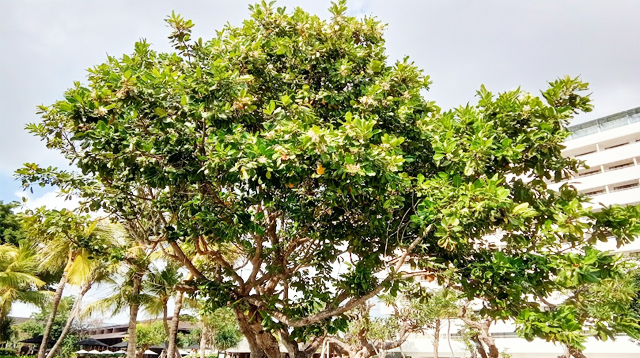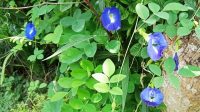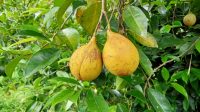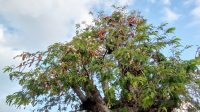IMAGINE walking on the beach with a fresh sea breeze, accompanied by the sound of rustling leaves shading your steps. That is the charm of the camplung tree or oil nut tree, the natural green that not only beautifies the scenery, but also provides coolness in the midst of the hot sun!
From its sturdy shape to the distinctive aroma of its flowers, this tree is the perfect ‘oasis’ for your nature tourism. Let’s get to know the camplung tree, an exotic shade tree that brings a comfortable atmosphere while protecting our coastal ecosystem!”
Exotic Shade Tree for the Beauty of Natural Tourism
The camplung tree (Calophyllum inophyllum), also known as nyamplung or tamanu, is one of the exotic trees often found in tropical areas, especially in Southeast Asia and the Pacific Islands. With its unique characteristics, extraordinary environmental benefits, and aesthetic appeal, this tree is often used as a shade tree in natural tourist attractions. In Bali, the camplung tree is an inseparable part of the natural landscape, beautifying beaches and pedestrian paths with natural green charm.
Characteristics of the Camplung Tree
The camplung tree has a large and sturdy shape with wide, shiny green leaves, giving a very attractive shade impression to tourists. This tree can grow up to 20-25 meters high, and has a dense canopy, making it an ideal choice as a shade tree. The flowers are small and white, spreading a soft fragrant aroma. The fruit is small and round, green to brownish when ripe.
The bark is hard and slightly cracked, adding to the unique texture of this tree. The presence of camplung trees around tourist destinations not only presents green scenery, but also presents natural beauty rich in local flora and fauna.
Habitat and Distribution
Camplung trees grow in lowlands near the coast or in tropical forest areas. In Indonesia, this tree can be found along the coast and also in certain highlands that have a humid climate and fertile soil.
Growing in sandy or muddy soil near the coast, this tree has an extraordinary ability to adapt to harsh environmental conditions, including exposure to sea winds and strong sunlight.
In coastal tourist locations such as Bali, Lombok, and several islands in Eastern Indonesia, camplung trees grow naturally and are often planted to beautify beach areas. Its resistance to sea salt and sandy soil makes it a favorite tree in coastal areas that function as natural protection.
Environmental Benefits of Camplung Trees
In addition to being a shade tree that provides a cool atmosphere, camplung trees have great benefits for the environment. The strong and extensive root system helps prevent coastal erosion, holding sand from being eroded by wind and waves. This is very important to maintain the beauty of the coastline which is often a favorite destination for tourists.
Camplung trees also play a role in maintaining the balance of the ecosystem, especially as a habitat for birds and insects that enrich the biodiversity around it. In addition, this tree helps absorb carbon dioxide and produces oxygen, supporting a cleaner and fresher environment.
Camplung Trees as Shade and Tourist Attractions
When tourists walk in an area lush with camplung trees, they will feel a cool and comfortable atmosphere, a calming experience from the hustle and bustle of the city. The large and dense shape of the tree is an ideal place for shelter, making tourists feel at home for a long time enjoying the beauty of nature while taking shelter from the hot sun.
In natural tourist attractions, such as parks and botanical gardens, camplung trees are often planted as shade and a place to relax for tourists. The beauty of this tree is a photographic attraction, because of its unique canopy shape and exotic natural background. In fact, several tourist destinations are starting to realize the potential of this tree as a green icon that can enrich the natural tourism experience.
Economic Value and Derivative Products
The fruit of the camplung tree produces seeds that contain high-quality essential oils, often referred to as tamanu oil, which have long been used in skin care and traditional medicine.
These derivative products have benefits for skin health, especially for treating wounds, reducing inflammation, and providing natural moisture. Some local products in Indonesia even use camplung oil as an ingredient in herbal cosmetics, so tourists can buy tamanu-based products as souvenirs.
In Bali, camplung wood is commonly used to make kentongan (traditional communication tools) and cow gongs because the material from this wood can produce a loud sound.
Conclusion
Camplung trees not only beautify tourist destinations with their beauty, but also provide invaluable environmental benefits. Its function asi shade and erosion control make it an important component in maintaining the beauty of coastal tourism areas.
With its existence, the camplung tree is able to blend in with the surrounding nature, offering shade, clean air, and the natural charm that tourists always seek.











